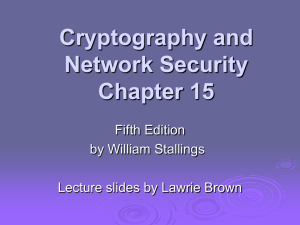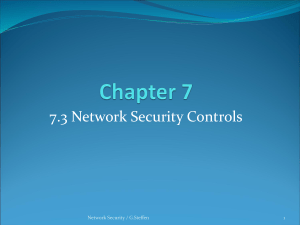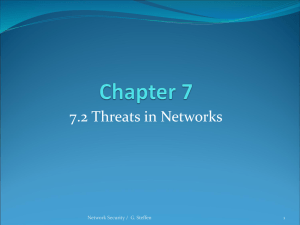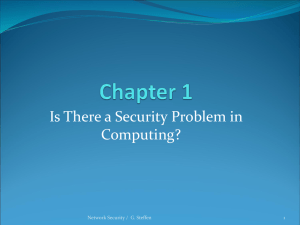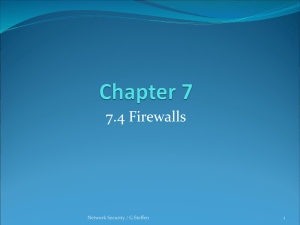Kerberos & Authentication
advertisement
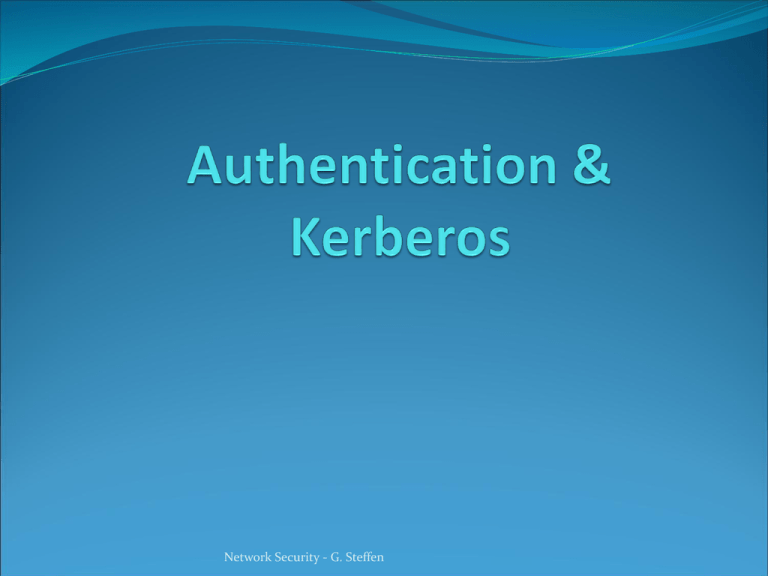
Network Security - G. Steffen User Authentication fundamental security building block basis of access control & user accountability is the process of verifying an identity claimed by or for a system entity has two steps: identification - specify identifier verification - bind entity (person) and identifier distinct from message authentication Network Security - G. Steffen Means of User Authentication four means of authenticating user's identity based one something the individual knows - e.g. password, PIN possesses - e.g. key, token, smartcard is (static biometrics) - e.g. fingerprint, retina does (dynamic biometrics) - e.g. voice, sign can use alone or combined all can provide user authentication all have issues Network Security - G. Steffen Authentication Protocols used to convince parties of each others identity and to exchange session keys may be one-way or mutual key issues are confidentiality – to protect session keys timeliness – to prevent replay attacks Network Security - G. Steffen Replay Attacks where a valid signed message is copied and later resent simple replay repetition that can be logged repetition that cannot be detected backward replay without modification countermeasures include use of sequence numbers (generally impractical) timestamps (needs synchronized clocks) challenge/response (using unique nonce) Network Security - G. Steffen One-Way Authentication required when sender & receiver are not in communications at same time (eg. email) have header in clear so can be delivered by email system may want contents of body protected & sender authenticated Network Security - G. Steffen Using Symmetric Encryption as discussed previously can use a two-level hierarchy of keys usually with a trusted Key Distribution Center (KDC) each party shares own master key with KDC KDC generates session keys used for connections between parties master keys used to distribute these to them Network Security - G. Steffen Needham-Schroeder Protocol original third-party key distribution protocol for session between A B mediated by KDC protocol overview is: 1. A->KDC: IDA || IDB || N1 2. KDC -> A: E(Ka,[Ks||IDB||N1|| E(Kb,[Ks||IDA])]) 3. A -> B: E(Kb, [Ks||IDA]) 4. B -> A: E(Ks, [N2]) 5. A -> B: E(Ks, [f(N2)]) Network Security - G. Steffen Needham-Schroeder Protocol used to securely distribute a new session key for communications between A & B but is vulnerable to a replay attack if an old session key has been compromised then message 3 can be resent convincing B that is communicating with A modifications to address this require: timestamps in steps 2 & 3 (Denning 81) using an extra nonce (Neuman 93) Network Security - G. Steffen One-Way Authentication use refinement of KDC to secure email since B no online, drop steps 4 & 5 protocol becomes: 1. A->KDC: IDA || IDB || N1 2. KDC -> A: E(Ka, [Ks||IDB||N1 || E(Kb,[Ks||IDA])]) 3. A -> B: E(Kb, [Ks||IDA]) || E(Ks, M) provides encryption & some authentication does not protect from replay attack Network Security - G. Steffen Kerberos trusted key server system from MIT provides centralised private-key third-party authentication in a distributed network allows users access to services distributed through network without needing to trust all workstations rather all trust a central authentication server two versions in use: 4 & 5 Network Security - G. Steffen Kerberos Requirements its first report identified requirements as: secure reliable transparent scalable implemented using an authentication protocol based on Needham-Schroeder Network Security - G. Steffen Kerberos v4 Overview a basic third-party authentication scheme have an Authentication Server (AS) users initially negotiate with AS to identify self AS provides a non-corruptible authentication credential (ticket granting ticket TGT) have a Ticket Granting server (TGS) users subsequently request access to other services from TGS on basis of users TGT using a complex protocol using DES Network Security - G. Steffen Kerberos v4 Dialogue Network Security - G. Steffen Kerberos 4 Overview Network Security - G. Steffen Kerberos Realms a Kerberos environment consists of: a Kerberos server a number of clients, all registered with server application servers, sharing keys with server this is termed a realm typically a single administrative domain if have multiple realms, their Kerberos servers must share keys and trust Network Security - G. Steffen Kerberos Realms Network Security - G. Steffen Kerberos Version 5 developed in mid 1990’s specified as Internet standard RFC 1510 provides improvements over v4 addresses environmental shortcomings encryption alg, network protocol, byte order, ticket lifetime, authentication forwarding, interrealm auth and technical deficiencies double encryption, non-std mode of use, session keys, password attacks Network Security - G. Steffen Kerberos v5 Dialogue Network Security - G. Steffen Remote User Authentication in Ch 14 saw use of public-key encryption for session key distribution assumes both parties have other’s public keys may not be practical have Denning protocol using timestamps uses central authentication server (AS) to provide public-key certificates requires synchronized clocks have Woo and Lam protocol using nonces care needed to ensure no protocol flaws Network Security - G. Steffen One-Way Authentication have public-key approaches for email encryption of message for confidentiality, authentication, or both must now public keys using costly public-key alg on long message for confidentiality encrypt message with one-time secret key, public-key encrypted for authentication use a digital signature may need to protect by encrypting signature use digital certificate to supply public key Network Security - G. Steffen Federated Identity Management use of common identity management scheme across multiple enterprises & numerous applications supporting many thousands, even millions of users principal elements are: authentication, authorization, accounting, provisioning, workflow automation, delegated administration, password synchronization, self-service password reset, federation Kerberos contains many of these elements Network Security - G. Steffen Identity Management Network Security - G. Steffen Identity Federation Network Security - G. Steffen Standards Used Security Assertion Markup Language (SAML) XML-based language for exchange of security information between online business partners part of OASIS (Organization for the Advancement of Structured Information Standards) standards for federated identity management e.g. WS-Federation for browser-based federation need a few mature industry standards Network Security - G. Steffen Federated Identity Examples Network Security - G. Steffen Summary have considered: remote user authentication issues authentication using symmetric encryption the Kerberos trusted key server system authentication using asymmetric encryption federated identity management Network Security - G. Steffen
